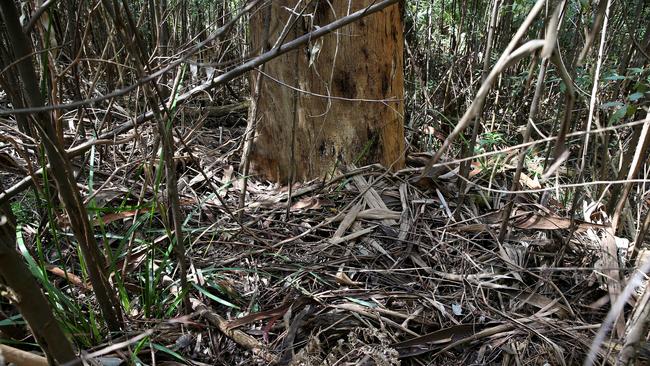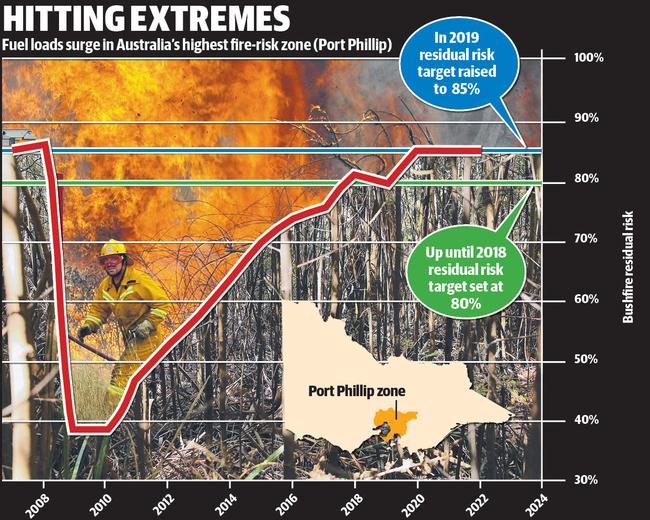Fuel loads soar as Andrews government plays with numbers
Forest Fire Management Victoria’s failure to reduce fuel loads means “accepting the same level of losses as Black Saturday”.

The bushfire risk in Victoria’s most dangerous and populous zone has hit 85 per cent, despite the Andrews government raising the acceptable residual risk level from 80 per cent just four years ago.
A 100 per cent residual risk assumes the most extreme loss of property from a fire, where the build-up of fuel loads has reached its maximum, due to no planned burning or major fires.
The nation’s top bushfire scientist, University of Melbourne Associate Professor Kevin Tolhurst said a residual risk of 85 per cent meant “we’re not much better off than no (fuel load) management at all” and we were “accepting the same level of losses as Black Saturday, when 2007 homes were destroyed” and 173 Victorians died.
“Clearly that’s not acceptable, otherwise we wouldn’t have had a Royal Commission,” Prof Tolhurst said. “What say do the public have in setting this (risk level)?”
In 2016 FFMVic set a target of keeping the residual risk below 80 per cent, in what was then the East Central zone.
But by 2019 the risk had risen from 39 per cent in the aftermath of Black Saturday’s fire storms to 80 per cent.
Rather than putting more resources into fuel-reduction burns and mechanical clearing, FFMVic simply changed the boundaries reducing the size of the East Central zone, renaming it Port Phillip and set the acceptable residual risk threshold to 85 per cent.
Despite moving the goalposts, FFMVic’s latest reports show Port Phillip’s residual risk is now sitting at 85 per cent, in a zone that extends from Melton to Kinglake and covers the Yarra Ranges, Bunyip State Park and Mornington Peninsula.

Prof Tolhurst and his colleague Derek Chong developed the Phoenix Rapid Fire computer model, which FFMVic uses to calculate residual risk.
Prof Tolhurst said setting the 85 per cent target “had more to do with what FFMVic thought was achievable, rather than what was desirable or acceptable”.
A Victorian government spokesman said the Port Phillip residual risk target had been set at 85 per cent, “due in large part to the density of population in the catchment area and the wet Ash forests around Melbourne, which are typically too damp for large-scale planned burning during the favourable periods of autumn and spring”.
“Bushfire risk is measured by the likelihood of a bushfire starting, spreading and impacting communities. For this reason, bushfire risk in highly populated forested areas around Melbourne will always be higher than in many other parts of the state,” the spokesman said.
Yet the 2009 Black Saturday Royal Commission set an annual fuel reduction target of 3850,000ha, equivalent to “5 per cent minimum of public land”.
But the Andrews government abandoned that target in 2015-16, opting instead to meet its own residual risk targets.
Since then FFMVic annual reports show it has fallen well short of the Royal Commission’s 385,000ha annual target, with its fuel reduction program delivering an annual average of 115,200ha over the past seven years.
FFMVic managed:
197,940ha of controlled burns in 2015-16
125,052ha in 2016-17
74,728ha in 2017-18
130,000ha in 2018-19
48,400ha in 2019-20
152,100ha in 2020-21
78,300 in 2021-22
The 2009 Royal Commission was scathing in its criticism of the former Bracks-Brumby Labor government’s Department of Sustainability and Environment for only setting a target of 130,000ha in the lead-up to Black Saturday.
The Andrews government has also redrawn the boundaries and raised the residual risk in two other key bushfire zones, by:
EXTENDING the Alpine and North East Zone to cover Marysville in 2019, renaming it the Hume region and lifting the residual risk from 60 per cent to 69 per cent. Since then fuel loads have built up and lifted the residual risk to 69 per cent.
EXTENDING the Alpine and Greater Gippsland zone in 2019 to cover the Thomson and Latrobe Valleys, and raising the risk level from 65 to 71 per cent. Prior to the 2019-20 Black Summer fires the residual risk had hit 72 per cent. Bushfires, not fuel reduction burns, have now reduced that risk to 42 per cent.




